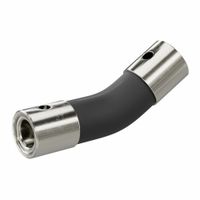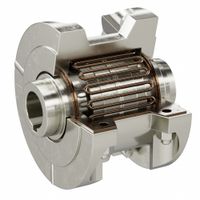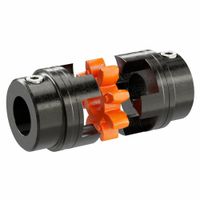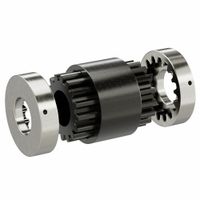Call +(254) 703 030 000 / 751 483 999 / 721 704 777
- Home
- Power Transmission
- Shaft Couplings Universal Joints
- Flexible Couplings
.....Read More
Frequently Asked Questions
What are the main types of flexible couplings?
Flexible couplings are mechanical devices used to connect two shafts, allowing for misalignment and accommodating movement while transmitting torque. The main types include:
1. **Jaw Couplings**: Consist of two metal hubs with jaws that interlock with an elastomeric spider. They are used for moderate misalignment and dampen vibrations.
2. **Elastomeric Couplings**: Utilize an elastic material to absorb shock and vibration. Common types include tire and sleeve couplings, which are suitable for applications requiring flexibility and vibration damping.
3. **Gear Couplings**: Comprise two hubs with external teeth that mesh with internal teeth on a sleeve. They handle high torque and accommodate angular, parallel, and axial misalignment.
4. **Disc Couplings**: Use a series of thin, flexible metal discs to transmit torque. They are ideal for high-speed applications and can handle angular and axial misalignment.
5. **Grid Couplings**: Feature a grid spring that fits into grooves on the coupling hubs. They provide high torque capacity and moderate misalignment accommodation, with good vibration damping.
6. **Oldham Couplings**: Consist of three parts: two hubs and a central disc that slides between them. They are used for small misalignments and provide zero backlash.
7. **Universal Joints**: Allow for large angular misalignments and are commonly used in applications requiring significant flexibility, such as drive shafts in vehicles.
8. **Bellows Couplings**: Made from thin-walled metal bellows, they offer high torsional stiffness and accommodate angular, parallel, and axial misalignment, suitable for precision applications.
9. **Chain Couplings**: Use a chain wrapped around sprockets on the coupling hubs. They are robust and handle high torque with some misalignment.
Each type of flexible coupling has specific advantages and is chosen based on the application's requirements for torque, speed, misalignment, and environmental conditions.
How do jaw couplings work?
Jaw couplings work by transmitting torque between two shafts while accommodating misalignment and dampening vibrations. They consist of three main components: two metallic hubs with jaws and an elastomeric element called a spider. The hubs are attached to the respective shafts, and the spider fits snugly between the jaws of the hubs.
When the coupling is assembled, the jaws of each hub interlock with the spider, which is typically made of a flexible material like rubber, urethane, or Hytrel. This design allows the coupling to handle angular, parallel, and axial misalignments between the connected shafts. The flexibility of the spider absorbs shocks and vibrations, protecting the machinery from damage and reducing noise.
As torque is applied, the hubs rotate, and the spider transmits the torque from one hub to the other. The elastomeric nature of the spider allows it to compress and deform slightly, accommodating misalignments and absorbing vibrations. This deformation also helps in maintaining the alignment of the shafts, ensuring efficient power transmission.
Jaw couplings are fail-safe, meaning that if the spider fails, the jaws of the hubs will still interlock, allowing the coupling to continue transmitting torque, albeit with increased wear and noise. They are easy to install and maintain, making them a popular choice in various applications, including pumps, compressors, and conveyors.
Overall, jaw couplings provide a reliable and cost-effective solution for connecting shafts in machinery, offering flexibility, vibration dampening, and the ability to handle misalignments.
What are the benefits of using sleeve couplings?
Sleeve couplings, also known as muff couplings, offer several benefits in mechanical systems:
1. **Simplicity and Cost-Effectiveness**: Sleeve couplings are simple in design, consisting of a hollow cylinder that fits over the ends of two shafts. This simplicity makes them cost-effective to manufacture and easy to install, reducing labor and material costs.
2. **Ease of Maintenance**: Due to their straightforward design, sleeve couplings require minimal maintenance. They can be easily disassembled and reassembled, facilitating quick repairs and replacements, which minimizes downtime.
3. **Alignment Tolerance**: Sleeve couplings can accommodate slight misalignments between connected shafts. This flexibility helps in reducing stress on the shafts and bearings, prolonging the lifespan of the machinery.
4. **Vibration Damping**: The design of sleeve couplings allows them to absorb and dampen vibrations between connected shafts. This reduces wear and tear on the machinery and contributes to smoother operation.
5. **Torque Transmission**: Sleeve couplings are effective in transmitting moderate levels of torque between shafts. They provide a secure connection that ensures efficient power transfer in various applications.
6. **Versatility**: These couplings are versatile and can be used in a wide range of applications, from light-duty to moderate-duty operations, across different industries such as manufacturing, automotive, and agriculture.
7. **Material Options**: Sleeve couplings are available in various materials, including steel, cast iron, and rubber, allowing for customization based on specific application requirements, such as load capacity and environmental conditions.
8. **Safety**: By securely connecting shafts, sleeve couplings help prevent accidents caused by shaft separation, ensuring safe operation of machinery.
Overall, sleeve couplings are a reliable and efficient choice for connecting shafts in many mechanical systems, offering a balance of performance, cost, and ease of use.
How do tire couplings absorb vibration and shock loads?
Tire couplings absorb vibration and shock loads primarily through their flexible and resilient design, which utilizes a rubber or elastomeric element shaped like a tire. This element is positioned between two metal flanges connected to the driving and driven shafts. The key mechanism by which tire couplings absorb vibrations and shocks is through the deformation of the rubber element.
1. **Elasticity**: The rubber element in tire couplings is highly elastic, allowing it to deform under load. This elasticity enables the coupling to absorb and dissipate energy from vibrations and shocks, reducing the transmission of these forces to connected machinery.
2. **Damping**: The inherent damping properties of rubber help in dissipating vibrational energy as heat. This damping effect reduces the amplitude of vibrations, providing smoother operation and protecting equipment from potential damage.
3. **Flexibility**: The flexible nature of the tire element accommodates misalignments between shafts, such as angular, parallel, and axial misalignments. This flexibility prevents the transmission of misalignment-induced stresses, which can lead to vibrations and shocks.
4. **Load Distribution**: The tire coupling's design allows for even distribution of loads across the rubber element. This uniform load distribution minimizes stress concentrations, enhancing the coupling's ability to absorb shocks.
5. **Isolation**: By isolating the driving and driven components, tire couplings prevent the direct transmission of vibrations and shocks. This isolation is crucial in protecting sensitive equipment and maintaining operational stability.
Overall, the combination of elasticity, damping, flexibility, load distribution, and isolation makes tire couplings effective in absorbing vibration and shock loads, thereby enhancing the longevity and reliability of mechanical systems.
What applications are chain couplings best suited for?
Chain couplings are best suited for applications that require the transmission of mechanical power between two shafts while accommodating some degree of misalignment. They are particularly effective in scenarios where high torque and low-speed operations are involved. These couplings are commonly used in heavy-duty applications due to their robust construction and ability to handle significant loads.
1. **Industrial Machinery**: Chain couplings are ideal for connecting motors to gearboxes, conveyors, and other machinery in industries such as manufacturing, mining, and material handling. They can efficiently transmit power in environments where equipment is subject to shock loads and vibrations.
2. **Pumps and Compressors**: In fluid handling systems, chain couplings are used to connect pumps and compressors to their driving motors. They provide the necessary flexibility to accommodate slight misalignments and reduce the risk of mechanical failure.
3. **Conveyors**: Chain couplings are well-suited for conveyor systems, where they can handle the high torque required to move heavy loads. They ensure smooth operation and can withstand the harsh conditions often found in material transport applications.
4. **Agricultural Equipment**: In agricultural machinery, such as tractors and harvesters, chain couplings are used to connect various implements and attachments. Their durability and ability to handle misalignment make them suitable for the rugged conditions of farming operations.
5. **Marine Applications**: Chain couplings are used in marine environments to connect engines to propeller shafts. Their ability to handle high torque and absorb shock loads makes them suitable for the demanding conditions at sea.
Overall, chain couplings are favored in applications where reliability, durability, and the ability to handle misalignment and high torque are critical.
How do grid couplings handle high-torque applications?
Grid couplings handle high-torque applications through their unique design and material properties, which provide flexibility, strength, and durability. They consist of a grid spring element that fits into grooves on two flanged hubs. This grid element is typically made from high-strength alloy steel, which allows it to withstand significant torque loads while maintaining flexibility.
The grid spring's serpentine shape enables it to flex under load, distributing stress evenly across the coupling. This design allows the coupling to absorb shock loads and dampen vibrations, which are common in high-torque applications. By reducing the transmission of these forces, grid couplings protect connected equipment from damage and extend their operational life.
Additionally, grid couplings accommodate misalignment between connected shafts, including angular, parallel, and axial misalignments. This capability is crucial in high-torque environments where perfect alignment is challenging to maintain. The ability to handle misalignment reduces the risk of excessive wear and tear on the coupling and connected machinery.
Grid couplings also feature a high torque-to-weight ratio, meaning they can transmit substantial torque without being excessively large or heavy. This makes them suitable for compact installations where space is limited but high torque transmission is required.
Furthermore, grid couplings are designed for easy maintenance. The grid element can be replaced without removing the entire coupling, minimizing downtime during maintenance operations. Proper lubrication of the grid element is essential to ensure smooth operation and longevity, as it reduces friction and wear.
Overall, the combination of material strength, flexible design, misalignment accommodation, and ease of maintenance makes grid couplings highly effective in handling high-torque applications.
What are the advantages of using flexible rubber couplings?
Flexible rubber couplings offer several advantages in mechanical systems:
1. **Vibration Damping**: Rubber's inherent elasticity allows it to absorb and dampen vibrations, reducing noise and wear on connected components.
2. **Misalignment Compensation**: These couplings can accommodate angular, parallel, and axial misalignments between shafts, minimizing stress on bearings and other components.
3. **Shock Absorption**: Rubber couplings can absorb shocks and sudden loads, protecting machinery from damage and extending the lifespan of components.
4. **Noise Reduction**: The damping properties of rubber help in reducing operational noise, contributing to a quieter working environment.
5. **Maintenance-Free**: Typically, rubber couplings require little to no maintenance, as they do not need lubrication and have fewer moving parts compared to other types of couplings.
6. **Cost-Effective**: They are generally less expensive than metallic couplings and offer a cost-effective solution for many applications.
7. **Corrosion Resistance**: Rubber is resistant to many chemicals and environmental conditions, making these couplings suitable for harsh environments.
8. **Ease of Installation**: Flexible rubber couplings are often easier to install and replace, reducing downtime and labor costs.
9. **Versatility**: Available in various sizes and configurations, they can be used in a wide range of applications, from small machinery to large industrial equipment.
10. **Energy Efficiency**: By reducing vibration and misalignment, rubber couplings can improve the energy efficiency of a system, leading to lower operational costs.
These advantages make flexible rubber couplings a popular choice in industries such as automotive, manufacturing, and power generation.





